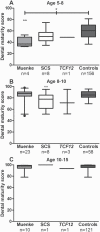Evaluation of dental maturity in Muenke syndrome, Saethre-Chotzen syndrome, and TCF12-related craniosynostosis
- PMID: 34424951
- PMCID: PMC9127722
- DOI: 10.1093/ejo/cjab056
Evaluation of dental maturity in Muenke syndrome, Saethre-Chotzen syndrome, and TCF12-related craniosynostosis
Abstract
Objectives: To determine whether dental maturity (dental development) was delayed in patients with Muenke syndrome, Saethre-Chotzen syndrome, and TCF12-related craniosynostosis, compared with a Dutch control group without syndromes.
Materials and methods: This study included 60 patients (38 patients with Muenke syndrome, 17 patients with Saethre-Chotzen syndrome, and 5 with TCF12-related craniosynostosis), aged 5.8-16.8 years that were treated at the Department of Oral Maxillofacial Surgery, Special Dental Care, and Orthodontics, in Sophia Children's Hospital, Erasmus University Medical Center, Rotterdam, the Netherlands. Dental age was calculated according to Demirjian's index of dental maturity. The control group included 451 children without a syndrome.
Results: Compared with the control group, dental development was delayed by an average of one year in 5- to 8-year-old patients with Muenke syndrome (P = 0.007) and in 8- to 10-year-old patients with Saethre-Chotzen syndrome (P = 0.044), but not in patients with TCF12-related craniosynostosis.
Conclusions: Our results indicated that dental development was delayed by one year, on average, in patients with Muenke syndrome and Saethre-Chotzen syndrome, compared with a Dutch control group without syndromes.
Implications: Our findings have improved the understanding of dental development in patients with Muenke and Saethre-Chotzen syndrome. These results can provide guidance on whether the orthodontist needs to consider growth disturbances related to dental development.
© The Author(s) 2021. Published by Oxford University Press on behalf of the European Orthodontic Society.
Figures




References
-
- French, L.R., Jackson, I.T. and Melton, L.J., III. (1990) A population-based study of craniosynostosis. Journal of Clinical Epidemiology, 43, 69–73. - PubMed
-
- Lajeunie, E., Le Merrer, M., Bonaïti-Pellie, C., Marchac, D. and Renier, D. (1995) Genetic study of nonsyndromic coronal craniosynostosis. American Journal of Medical Genetics, 55, 500–504. - PubMed
-
- Singer, S., Bower, C., Southall, P. and Goldblatt, J. (1999) Craniosynostosis in Western Australia, 1980–1994: a population-based study. American Journal of Medical Genetics, 83, 382–387. - PubMed
-
- Boulet, S.L., Rasmussen, S.A. and Honein, M.A. (2008) A population-based study of craniosynostosis in metropolitan Atlanta, 1989–2003. American Journal of Medical Genetics, 146A, 984–991. - PubMed
-
- Kweldam, C.F., van der Vlugt, J.J. and van der Meulen, J.J. (2011) The incidence of craniosynostosis in the Netherlands, 1997–2007. Journal of Plastic Reconstructive Aesthetic Surgery, 64, 583–588. - PubMed

